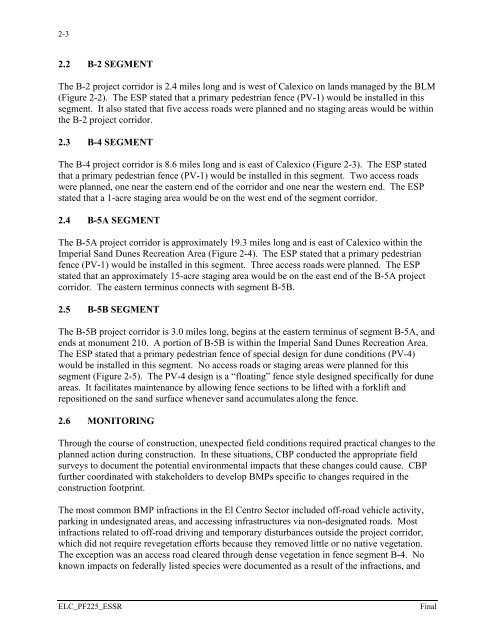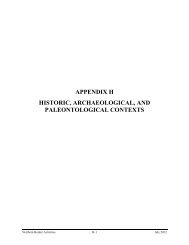El Centro PF225 ESSR - CBP.gov
El Centro PF225 ESSR - CBP.gov
El Centro PF225 ESSR - CBP.gov
Create successful ePaper yourself
Turn your PDF publications into a flip-book with our unique Google optimized e-Paper software.
2-3<br />
2.2 B-2 SEGMENT<br />
The B-2 project corridor is 2.4 miles long and is west of Calexico on lands managed by the BLM<br />
(Figure 2-2). The ESP stated that a primary pedestrian fence (PV-1) would be installed in this<br />
segment. It also stated that five access roads were planned and no staging areas would be within<br />
the B-2 project corridor.<br />
2.3 B-4 SEGMENT<br />
The B-4 project corridor is 8.6 miles long and is east of Calexico (Figure 2-3). The ESP stated<br />
that a primary pedestrian fence (PV-1) would be installed in this segment. Two access roads<br />
were planned, one near the eastern end of the corridor and one near the western end. The ESP<br />
stated that a 1-acre staging area would be on the west end of the segment corridor.<br />
2.4 B-5A SEGMENT<br />
The B-5A project corridor is approximately 19.3 miles long and is east of Calexico within the<br />
Imperial Sand Dunes Recreation Area (Figure 2-4). The ESP stated that a primary pedestrian<br />
fence (PV-1) would be installed in this segment. Three access roads were planned. The ESP<br />
stated that an approximately 15-acre staging area would be on the east end of the B-5A project<br />
corridor. The eastern terminus connects with segment B-5B.<br />
2.5 B-5B SEGMENT<br />
The B-5B project corridor is 3.0 miles long, begins at the eastern terminus of segment B-5A, and<br />
ends at monument 210. A portion of B-5B is within the Imperial Sand Dunes Recreation Area.<br />
The ESP stated that a primary pedestrian fence of special design for dune conditions (PV-4)<br />
would be installed in this segment. No access roads or staging areas were planned for this<br />
segment (Figure 2-5). The PV-4 design is a “floating” fence style designed specifically for dune<br />
areas. It facilitates maintenance by allowing fence sections to be lifted with a forklift and<br />
repositioned on the sand surface whenever sand accumulates along the fence.<br />
2.6 MONITORING<br />
Through the course of construction, unexpected field conditions required practical changes to the<br />
planned action during construction. In these situations, <strong>CBP</strong> conducted the appropriate field<br />
surveys to document the potential environmental impacts that these changes could cause. <strong>CBP</strong><br />
further coordinated with stakeholders to develop BMPs specific to changes required in the<br />
construction footprint.<br />
The most common BMP infractions in the <strong>El</strong> <strong>Centro</strong> Sector included off-road vehicle activity,<br />
parking in undesignated areas, and accessing infrastructures via non-designated roads. Most<br />
infractions related to off-road driving and temporary disturbances outside the project corridor,<br />
which did not require revegetation efforts because they removed little or no native vegetation.<br />
The exception was an access road cleared through dense vegetation in fence segment B-4. No<br />
known impacts on federally listed species were documented as a result of the infractions, and<br />
ELC_<strong>PF225</strong>_<strong>ESSR</strong><br />
Final
















